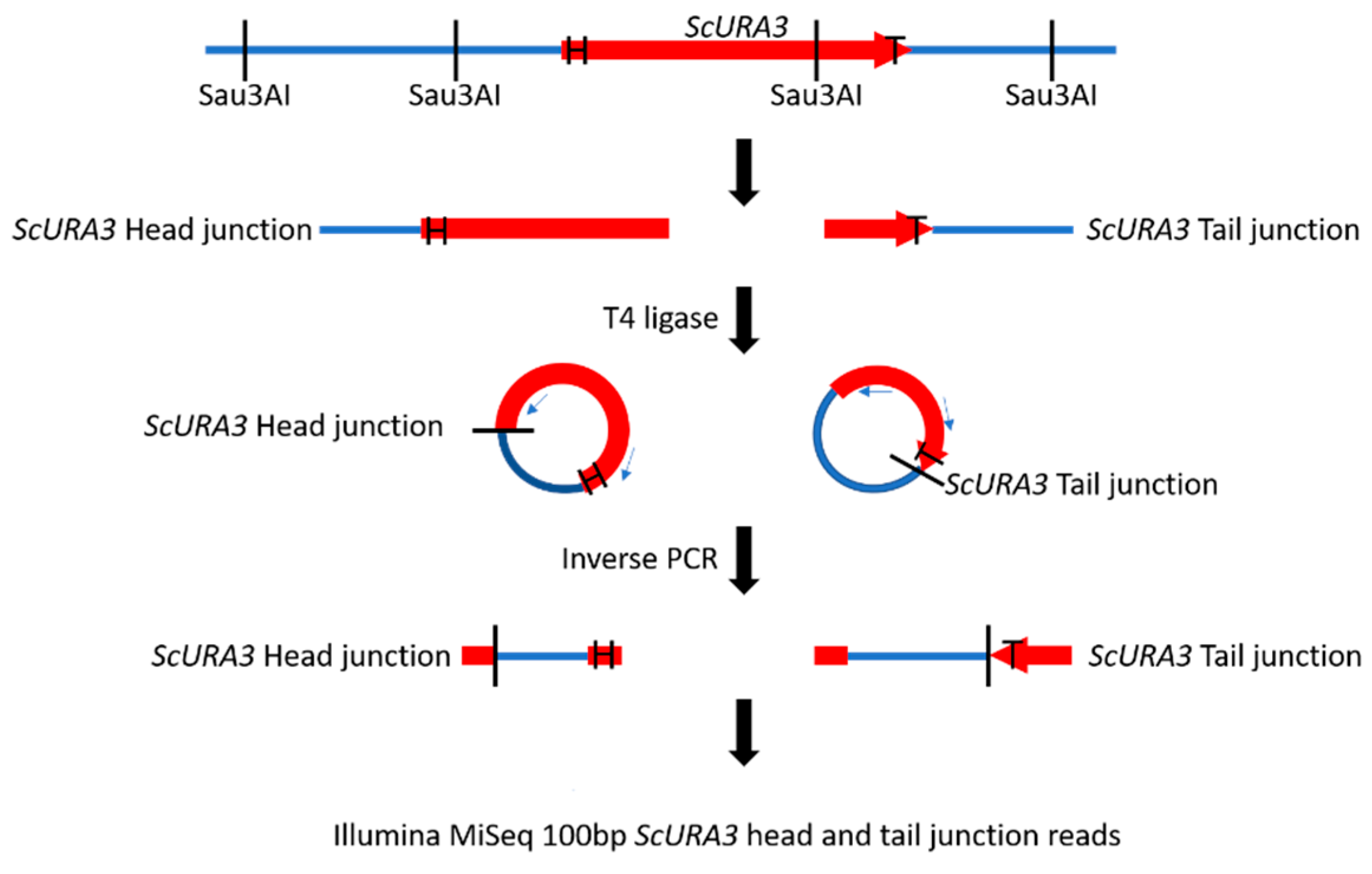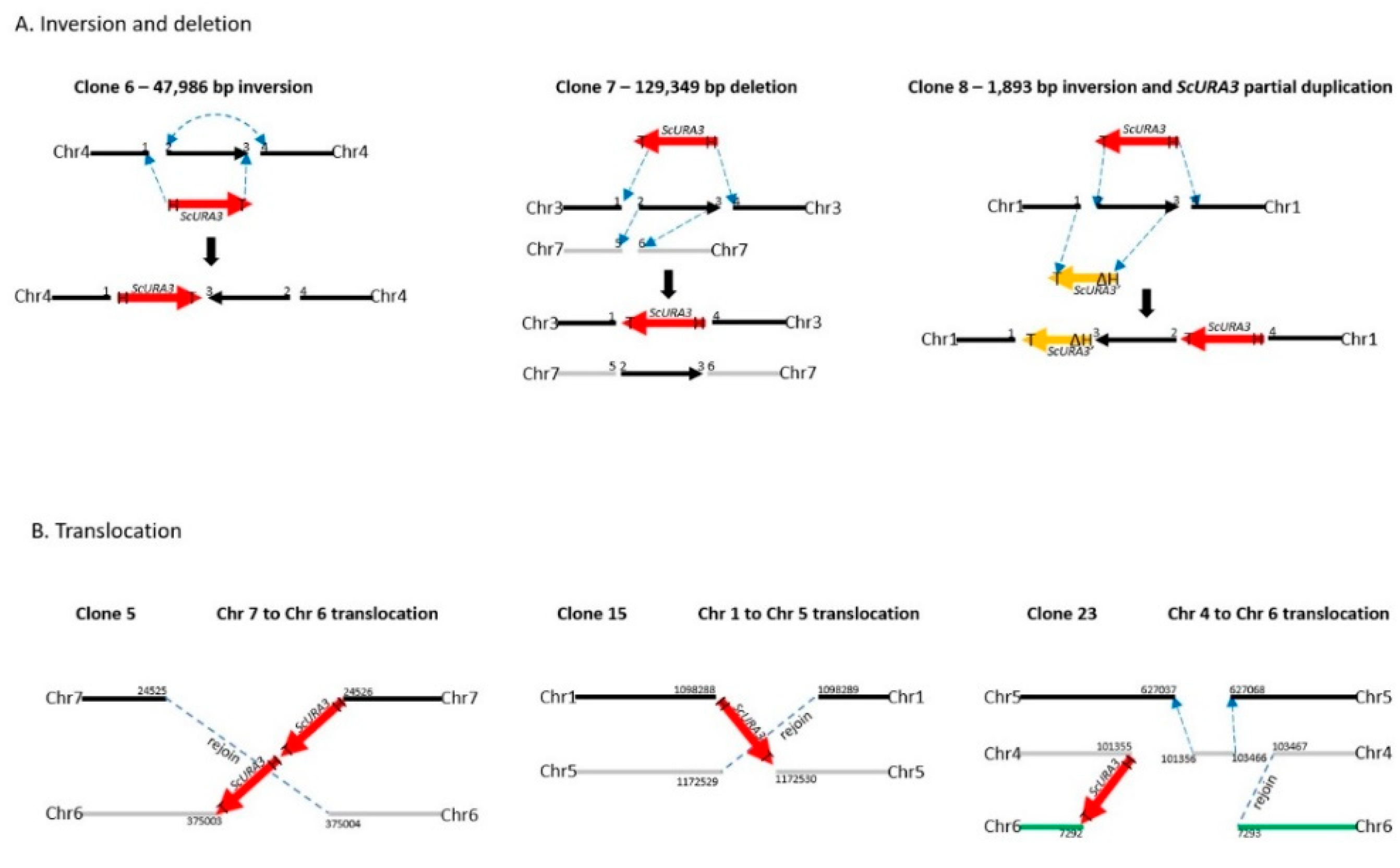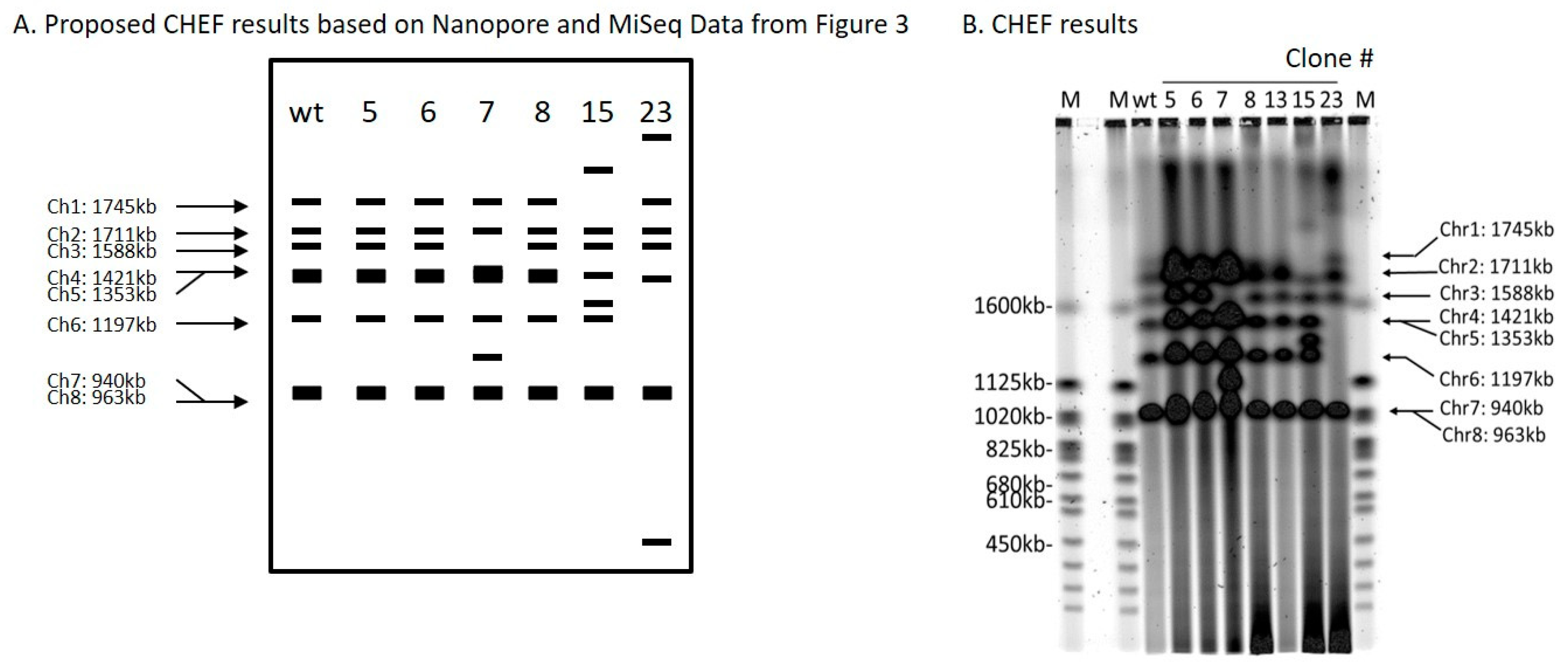Gross Chromosomal Rearrangements in Kluyveromyces marxianus Revealed by Illumina and Oxford Nanopore Sequencing
Abstract
1. Introduction
2. Results
2.1. Determination of ScURA3 Genomic Insertion Sites by Illumina MiSeq Analysis
2.2. Concatemer Dimer and Trimer ScURA3 Inserts
2.3. Sixteen ScURA3 Insertion Events Were Either Precise or Resulted in Small Deletions of Genome Sequence
2.4. Two ScURA3 Insertion Events Were Simple Insertions but Involved Corruption of the ScURA3 Termini
2.5. Three ScURA3 Insertions Resulted in Large Chromosomal Inversions or Deletions
2.6. Three ScURA3 Insertions Resulted in Inter-Chromosomal Translocations
3. Discussion
4. Materials and Methods
4.1. Yeast Strains
4.2. Preparation of ScURA3 Cassette DNA
4.3. Isolation of K. marxianus ScURA3 Transformants and Preparation of Transformant DNAs
4.4. Preparation of 24-Clone Pool DNA Libraries for Illumina MiSeq Sequencing
4.5. Oxford Nanopore Sequencing
4.6. CHEF Genomic DNA Plug Preparation
4.7. Pulsed-Field Gel Electrophoresis (PFGE)
Supplementary Materials
Author Contributions
Funding
Conflicts of Interest
References
- Banat, I.M.; Nigam, P.; Marchant, R. Isolation of thermotolerant, fermentative yeasts growing at 52 °C and producing ethanol at 45 °C and 50 °C. World J. Microbiol. Biotechnol. 1992, 8, 259–263. [Google Scholar] [CrossRef] [PubMed]
- Groeneveld, P.; Stouthamer, A.H.; Westerhoff, H.V. Super life—How and why ‘cell selection’ leads to the fastest-growing eukaryote. FEBS J. 2009, 276, 254–270. [Google Scholar] [CrossRef] [PubMed]
- Rajkumar, A.S.; Varela, J.A.; Juergens, H.; Daran, J.G.; Morrissey, J.P. Biological Parts for Kluyveromyces marxianus Synthetic Biology. Front. Bioeng. Biotechnol. 2019, 7, 97. [Google Scholar] [CrossRef] [PubMed]
- Lee, M.H.; Lin, J.J.; Lin, Y.J.; Chang, J.J.; Ke, H.M.; Fan, W.L.; Wang, T.Y.; Li, W.H. Genome-wide prediction of CRISPR/Cas9 targets in Kluyveromyces marxianus and its application to obtain a stable haploid strain. Sci. Rep. 2018, 8, 7305. [Google Scholar] [CrossRef] [PubMed]
- Lobs, A.K.; Engel, R.; Schwartz, C.; Flores, A.; Wheeldon, I. CRISPR-Cas9-enabled genetic disruptions for understanding ethanol and ethyl acetate biosynthesis in Kluyveromyces marxianus. Biotechnol. Biofuels 2017, 10, 164. [Google Scholar] [CrossRef] [PubMed]
- Choo, J.H.; Han, C.; Kim, J.Y.; Kang, H.A. Deletion of a KU80 homolog enhances homologous recombination in the thermotolerant yeast Kluyveromyces marxianus. Biotechnol. Lett. 2014, 36, 2059–2067. [Google Scholar] [CrossRef] [PubMed]
- Hoshida, H.; Murakami, N.; Suzuki, A.; Tamura, R.; Asakawa, J.; Abdel-Banat, B.M.; Nonklang, S.; Nakamura, M.; Akada, R. Non-homologous end joining-mediated functional marker selection for DNA cloning in the yeast Kluyveromyces marxianus. Yeast 2014, 31, 29–46. [Google Scholar] [CrossRef] [PubMed]
- Kegel, A.; Martinez, P.; Carter, S.D.; Astrom, S.U. Genome wide distribution of illegitimate recombination events in Kluyveromyces lactis. Nucleic Acids Res. 2006, 34, 1633–1645. [Google Scholar] [CrossRef][Green Version]
- Abdel-Banat, B.M.; Nonklang, S.; Hoshida, H.; Akada, R. Random and targeted gene integrations through the control of non-homologous end joining in the yeast Kluyveromyces marxianus. Yeast 2010, 27, 29–39. [Google Scholar]
- Maassen, N.; Freese, S.; Schruff, B.; Passoth, V.; Klinner, U. Nonhomologous end joining and homologous recombination DNA repair pathways in integration mutagenesis in the xylose-fermenting yeast Pichia stipitis. FEMS Yeast Res. 2008, 8, 735–743. [Google Scholar] [CrossRef]
- Cormack, B.P.; Falkow, S. Efficient homologous and illegitimate recombination in the opportunistic yeast pathogen Candida glabrata. Genetics 1999, 151, 979–987. [Google Scholar] [PubMed]
- Nonklang, S.; Abdel-Banat, B.M.; Cha-aim, K.; Moonjai, N.; Hoshida, H.; Limtong, S.; Yamada, M.; Akada, R. High-temperature ethanol fermentation and transformation with linear DNA in the thermotolerant yeast Kluyveromyces marxianus dmku3-1042. Appl. Environ. Microbiol. 2008, 74, 7514–7521. [Google Scholar] [CrossRef] [PubMed]
- Hutchison, C.A., 3rd; Chuang, R.Y.; Noskov, V.N.; Assad-Garcia, N.; Deerinck, T.J.; Ellisman, M.H.; Gill, J.; Kannan, K.; Karas, B.J.; Ma, L.; et al. Design and synthesis of a minimal bacterial genome. Science 2016, 351, aad6253. [Google Scholar] [CrossRef]
- Hutchison, C.A.; Peterson, S.N.; Gill, S.R.; Cline, R.T.; White, O.; Fraser, C.M.; Smith, H.O.; Venter, J.C. Global transposon mutagenesis and a minimal mycoplasma genome. Science 1999, 286, 2165–2169. [Google Scholar] [CrossRef]
- Lieber, M.R. The mechanism of double-strand DNA break repair by the nonhomologous DNA end-joining pathway. Annu. Rev. Biochem. 2010, 79, 181–211. [Google Scholar] [CrossRef]




| Clone # | Primer Set | Chr | Head Junction Location | Tail Junction Location | Type of Insertion and Base Pair Involved | ScURA3 | Gene or Intergenic Insertion | |
|---|---|---|---|---|---|---|---|---|
| 1 * | none | 1 | 397946 | 397947 | precise | 0 bp | monomer | SG4EUKG585063 (ADE1) |
| 3 | 2 | 2 | 628004 | 628003 | precise | 0 bp | dimer | SG4EUKG585526 |
| 17 | 16 | 1 | 560632 | 560631 | precise | 0 bp | monomer | intergenic |
| 2 | 1 | 1 | 1128870 | 1128881 | del | 10 bp | trimer | intergenic |
| 4 | 26 | 4 | 1364429 | 1364423 | del | 5 bp | monomer | SG4EUKG587507 |
| 9 | 37 | 7 | 185317 | 185307 | del | 9 bp | monomer | intergenic |
| 10 | 11 | 2 | 1256630 | 1256656 | del | 25 bp | monomer | intergenic |
| 11 | 21 | 5 | 525553 | 525567 | del | 13 bp | monomer | intergenic |
| 12 | 4 | 6 | 166286 | 166289 | del | 2 bp | trimer | intergenic |
| 13 * | none | ? | ? | ? | ? | ? | monomer | ? |
| 14 | 20 | 6 | 392781 | 392769 | del | 11 bp | monomer | intergenic |
| 16 | 25 | 3 | 718057 | 718026 | del | 30 bp | monomer | intergenic |
| 18 | 27 | 5 | 821611 | 821620 | del | 8 bp | monomer | SG4EUKG588009 |
| 19 | 3 | 5 | 1339373 | 1339385 | del | 11 bp | dimer | intergenic |
| 20 | chr8 | 8 | 866469 | 866482 | del | 12 bp | monomer | SG4EUKG589280 |
| 21 | 32 | 1 | 926450 | 926445 | del | 4 bp | monomer | intergenic |
| 22 | 12 | 2 | 826489 | 826479 | del | 9 bp | monomer | SG4EUKG585988 |
| 24 | 17 | 1 | 1643311 | 1643296 | del | 14 bp | monomer | intergenic |
| 6 | 9 | 4 | 714164 | 762150 | inversion | 47,986 bp | monomer | intergenic-intergenic |
| 7 | 7 | 3 | 953765 | 824416 | del | 129,349 bp | monomer | intergenic-intergenic |
| 8 | 5 | 1 | 377332 | 375438 | inversion | 1892 bp | monomer | SG4EUKG584656-intergenic |
| 5 | cl5 | 7–6 | 24526(7) | 375003(6) | Translocation | Translocation | dimer | intergenic-intergenic |
| 15 | 10 | 1–5 | 1098288(1) | 1165171(5) | Translocation | Translocation | monomer | intergenic-intergenic |
| 23 | 8 | 4–6 | 101355(4) | 7292(6) | Translocation | Translocation | monomer | SG4EUKG586913-intergenic |
© 2020 by the authors. Licensee MDPI, Basel, Switzerland. This article is an open access article distributed under the terms and conditions of the Creative Commons Attribution (CC BY) license (http://creativecommons.org/licenses/by/4.0/).
Share and Cite
Ding, L.; Macdonald, H.D.; Smith, H.O.; Hutchison III, C.A.; Merryman, C.; Michael, T.P.; Abramson, B.W.; Kannan, K.; Liang, J.; Gill, J.; et al. Gross Chromosomal Rearrangements in Kluyveromyces marxianus Revealed by Illumina and Oxford Nanopore Sequencing. Int. J. Mol. Sci. 2020, 21, 7112. https://doi.org/10.3390/ijms21197112
Ding L, Macdonald HD, Smith HO, Hutchison III CA, Merryman C, Michael TP, Abramson BW, Kannan K, Liang J, Gill J, et al. Gross Chromosomal Rearrangements in Kluyveromyces marxianus Revealed by Illumina and Oxford Nanopore Sequencing. International Journal of Molecular Sciences. 2020; 21(19):7112. https://doi.org/10.3390/ijms21197112
Chicago/Turabian StyleDing, Lin, Harrison D. Macdonald, Hamilton O Smith, Clyde A. Hutchison III, Chuck Merryman, Todd P. Michael, Bradley W. Abramson, Krishna Kannan, Joe Liang, John Gill, and et al. 2020. "Gross Chromosomal Rearrangements in Kluyveromyces marxianus Revealed by Illumina and Oxford Nanopore Sequencing" International Journal of Molecular Sciences 21, no. 19: 7112. https://doi.org/10.3390/ijms21197112
APA StyleDing, L., Macdonald, H. D., Smith, H. O., Hutchison III, C. A., Merryman, C., Michael, T. P., Abramson, B. W., Kannan, K., Liang, J., Gill, J., Gibson, D. G., & Glass, J. I. (2020). Gross Chromosomal Rearrangements in Kluyveromyces marxianus Revealed by Illumina and Oxford Nanopore Sequencing. International Journal of Molecular Sciences, 21(19), 7112. https://doi.org/10.3390/ijms21197112





